Students must start practicing the questions from CBSE Sample Papers for Class 12 Biology with Solutions Set 12 are designed as per the revised syllabus.
CBSE Sample Papers for Class 12 Biology Set 12 with Solutions
Time : 3 Hours
Maximum Marks : 70
General Instructions:
- All questions are compulsory.
- The question paper has five sections and 33 questions. All questions are compulsory.
- Section-A has 16 questions of 1 mark each; Section-B has 5 questions of 2 marks each; Section-C has 7 questions of 3 marks each; Section-D has 2 case-based questions of 4 marks each; and Section-E has 3 questions of 5 marks each.
-
There is no overall choice. However, internal choices have been provided in some questions.
A student has to attempt only one of the alternatives in such questions. - Wherever necessary, neat and properly labelled diagrams should be drawn.
Section A
Question 1.
The relationship between genes and DNA are best understood by
(a) mutation
(b) recombination
(c) enzymatic synthesis of amino acid
(d) enzymatic synthesis of codons
Answer:
(a) Mutation gives rise to alternation in the phenotype.
This is the reason why mutation is considered best for studying the relationship between genes and DNAfor their expression.
Question 2.
Turning of the lips and finger nails colour into grey to bluish is the symptom of which of the following disease?
(a) Ascariasis
(b) Typhoid
(c) Pneumonia
(d) Malaria
Answer:
(c) Pneumonia is a bacterial disease caused by bacterium Streptococcus pneumoniae and Haemophilus influenzae. They infect the alveoli of lungs which lead to severe problem, in respiration.
In the severe cases of pneumonia, the lips and finger nails turn grey the bluish in colour.
Question 3.
A heavily bleeding and bruised road accident victim was given an injection to protect him against tetanus. Identify the treatment and the type of immunity developed from the given table to treat a person against tetanus.
| Remedy | Immunity | |
| (a) | Inactivated proteins | Active |
| (b) | Proteins of the venom | Passive |
| (c) | Preformed antibodies | Passive |
| (d) | Dead microorganism | Active |
Answer:
(c) The person is treated with tetanus injection which contain preformed antibodies to provide quick immune response against deadly-microbes. As here the person is given antibodies, rather than producing them through his own immune system. Thus, this type of immunity is called passive immunity.
Question 4.
An infertile couple was advised to undergo Artificial Insemination (AI) technique by the doctor. They opt for IUI. Out of the options given below, select the correct for the chosen process.
(a) Embryo with more than 8 blastomeres is transferred into the uterus
(b) Semen collected from donor or husband is transferred into the uterus
(c) Embryos upto 8 blastomeres is transferred into the uterus
(d) Sperm collected from donor or husband is directly injected into the ovum of the female
Answer:
(b) Artificial Insemination (Al) is performed in those cases where either the male partner is unable to inseminate the female or the sperm count is very low. In IUI (Intra Uterine Insemination), the semen collected from donor or male is introduced either into the vagina or into the uterus of female, to facilitate fertilisation.
![]()
Question 5.
In embryo sac, the number of snergid → egg cell → central cell → antipodal cell follows the order.
(a) 1 – 1 – 2 – 3
(b) 2 – 1 – 3 – 2
(c) 2 – 1 – 1 – 3
(d) 3 – 2 – 1 – 2
Answer:
(c) The functional megaspores develops into the embryo sac containing 2 synergids, 1 egg cell, 1 central cell and 3 antipodal cells. Thus, option (c) gives the correct number of different cells in an embryo sac.
Question 6.
A biologist studies the population of rats. He found that the average natality was 250, average mortality 240, immigration 20 and emigration 30. So, the net increase in population will be
(a) 10
(b) 15
(c) 05
(d) 0
Answer:
(d) The net increase in population would be zero. It can be calculated as
Increase in population = (Natality + Immigration) – (Mortality + Emigration)
⇒ (250 + 20) – (240 + 30) = 0
Hence, the net increase in population will be zero.
Question 7.
Which one of the following is related to ex situ conservation of threatened animals and plants?
(a) Wildlife safari parks
(b) Biodiversity hotspots
(c) Amazon rainforests
(d) Himalayan region
Answer:
(a) Wildlife safari parks are used for ex situ conservation of threatened animals and plants. In such conservation method, organisms are taken out from their natural habitat and are placed in special setting. Here, they are protected and give special care.
Question 8.
Identify what the given diagram indicates?
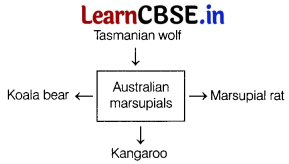
(a) Convergent evolution
(b) Divergent evolution
(c) Recapitulation
(d) Parallel evolution
Answer:
(a) Convergent evolution.
Adaptive radiation in Australian marsupials in an example of convergent evolution. In this case, the organisms under consideration are not closely related to one another in any way. But they independently develop similar trait as they have to adapt to the similar environment.
Question 9.
Which of the following water sample in the table given below, will be consider effluent of secondary treatment?
| Water samples | Aerobic microbes | BOD levels |
| (a) | High | High |
| (b) | Low | High |
| (o) | Low | Low |
| (d) | High | Low |
Answer:
(c) The effluent from secondary treatment has low BOD level and are free (i.e low) from aerobic microbes. This effluent is generally released into natural water bodies like rivers and streams.
Question 10.
Calculation of energy content, biomass or numbers, includes all the organisms at that trophic level. Taking pyramids into account on this, choose the correct option with reference to grassland ecosystem.
| Pyramid of biomass | Pyramid of number | |
| (a) | Upright | Inverted |
| (b) | Inverted | Inverted |
| (c) | Inverted | Upright |
| (d) | Upright | Upright |
Answer:
(d) In a grassland ecosystem, the number of producers is always higher, while the other organisms that are dependent directly or indirectly on producers, decreases at each trophic level. Thus, the pyramid becomes upright.
Similarly, the pyramid of biomass is upright as grasses occupy the base with the highest biomass followed by primary, secondary and tertiary consumers.
![]()
Question 11.
Species facing competition might evolve mechanism that promotes co-existence rather than exclusion. One such mechanism is
(a) competitive release
(b) resources partitioning
(c) co-evolution
(d) None of the above
Answer:
(b) Sometimes species facing interspecific competition might evolve mechanisms that promote co-existence rather than exclusion. One such mechanism is resource partitioning. In this mechanism, two species competing for the same resource, avoid competitions by choosing different times for feeding or different foraging pattern.
Question 12.
A figure below shows the structure of plasmid.
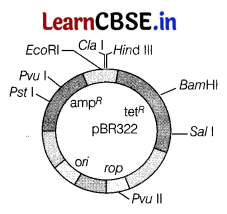
A foreign DNA was ligated at Pvu I. The transformants were then grown in a medium containing antibiotics ampicillin and tetracycline.
Choose the correct observation for the growth of bacterial colonies from the given table.
| Medium with tetracycline | Medium with ampicillin | |
| (a) | Growth | No growth |
| (b) | No growth | Growth |
| (c) | No growth | No growth |
| (d) | Growth | Growth |
Answer:
(a) Bacterial colonies will show no growth in the medium containing ampicillin, whereas the growth will be observed in the medium containing tetracycline. Ligation of foreign DNA at Pvu I and Pst I of ampicillin resistant gene in vector pBR322 will result in recombinants without ampicillin resistance. Thus, transformants tends to grow on tetracycline resistance medium, but not on ampicillin resistance medium.
Question Nos. 13 to 16 consist of two statements, Assertion (A) and Reason (R). Answer these questions selecting the appropriate option given below.
(a) Both Assertion and Reason are true, but Reason is the correct explanation of Assertion
(b) Both Assertion and Reason are true, but Reason is not the correct explanation of Assertion
(c) Assertion is true, but Reason is false
(d) Assertion is false, but Reason is true
Question 13.
Assertion (A) : Many crops are incorporated with foreign genes to make them tolerant to abiotic stress.
Reason (R) : Genomes of many plants are manipulated or altered by combining them with other genes to get desired trait.
Answer:
(a) Both Assertion and Reason are true and Reason is the correct explanation of Assertion.
The genomes of many plants are manipulated or altered by combining them with other genes to get . desired traits. These crops are called GM crops that are with incorporated foreign genes that have made more tolerant to abiotic stresses.
Question 14.
Assertion (A) : The presently occurring species extinction is different from the earlier mass extinction.
Reason (R) : Present species extinction is due to natural causes, whereas the earlier extinction was due to the man-made causes.
Answer:
(c) Assertion is true, but Reason is false. Reason can be corrected as
The currently occurring species extinction is different from the earlier mass extinction as the present species extinction is due to man-made causes, whereas the earlier extinction was due to the natural causes.
Question 15.
Assertion (A) : Some genes tend to pass together from one generation to another.
Reason (R) : Such genes are located far away from each other on a chromosome.
Answer:
(c) Assertion is true, but Reason is false,
Genes, which tend to get passed on together from one generation to the next, are located very close to each other on a chromosome. Such genes are called as linked genes.
Question 16.
Assertion (A) : In apomixis, the plants of new genetic sequence are produced.
Reason (R) : In apomixis, two organisms of same genetic sequence meet.
Answer:
(d) Assertion is false, but Reason is true.
In apomixis, sexual reproduction is completely I replaced by asexual reproduction. In this process no genetic sequence is formed as the progeny is genetically identical to the parent.
Section B
Question 17.
How are the DNA fragments separated by gel electrophoresis visualised and separated for use in constructing recombinant DNA.
Answer:
A compound called Ethidium Bromide (EtBr) stains DNA, which on exposure with ultraviolet radiation gives orange light. Hence, fragments appear as orange bands.
![]()
Question 18.
Observe the given figure and answer accordingly.
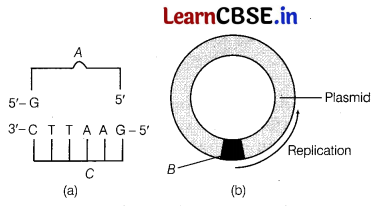
(i) Identify A and B. Mention the term given to A and C also explain why they are called so.
(ii) Expand PCR. Mention its importance in biotechnology.
Answer:
(i) A is AATTC, palindromic nucleotide sequence recognised by restriction endonuclease. Whereas B is Pvu II, origin of replications.
A and C depicts palindromic nucleotide sequence because it is a sequence of base pairs that reads same on the two strands when orientation of reading is kept the same.
(ii) PCR stands for Polymerase Chain Reaction. It is used to amplify DNA segments to a large number within a short span of time.
Question 19.
Study the diagram given below and answer the questions that follows.
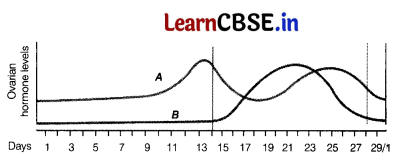
(i) Why is menstruation also called weeping of the uterus?
(ii) When does ovulation occur? Mention the name of the hormone secreted by corpus luteum.
Answer:
(i) Menstruation is also called weeping of uterus for the lost ovum or funeral of unfertilised egg.
(ii) Ovulation occurs at middle of cycle. The hormone progesterone is secreted by corpus luteum.
Question 20.
Given below is a diagrammatic representation of lymph nodes. Observe it carefully and answer the questions that follows.
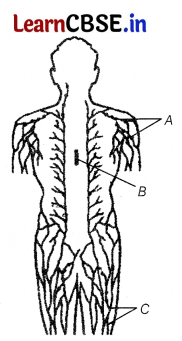
(i) Identify the labelled parts A, B and C. Highlight the role of B as a lymphoid organ.
(ii) Give the name of the cells that are released from the above mentioned gland. Mention how they help in immunity.
Answer:
(i) The labelled parts A, B and C are lymph nodes, thymus, lymphatic vessels, respectively. Thymus (B) is a primary lymphoid organ. It is lobe-shaped and is known to be the site for growth and differentiation of antigen sensitive T-lymphocytes.
(ii) Thymus releases T-lymphocytes, which are involved in cell-mediated immunity and also help B-lymphocytes to produce antibodies.
Question 21.
The given pyramid illustrate the connection between different trophic level is given below.
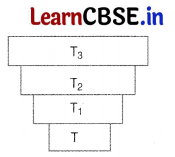
(i) Identify the type of ecological pyramid. Also give example of such type of pyramids.
(ii) Explain what do the base and the apex of this pyramid indicate.
Or
Draw the pyramids of biomass in a sea and in a forest. What will be the shape of these pyramids? Why are the two pyramids different from each other?
Answer:
(i) The given pyramid is an inverted ecological pyramid. The pyramid of number in a tree ecosystem and the pyramid of biomass in a pond ecosystem are also inverted.
(ii) The base and the apex of pyramid represents the producer and tertiary level’ consumer, respectively.
Or
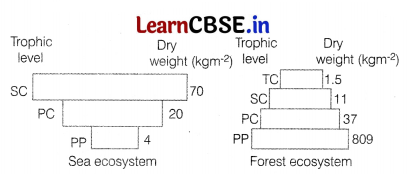
The pyramid of sea ecosystem will be inverted, whereas the pyramid of forest ecosystem will be upright.
The pyramid of sea ecosystem is inverted because the some total weight of phytoplankton is far less than a few fishes feeding at higher trophic level.
The pyramid of forest ecosystem is upright because producers are more in biomass than primary consumers.
Section C
Question 22.
Schematic representation of DNA fingerprints are shown below. ‘C’ is a sample taken from a crime scene, A and B from two suspected individuals. Carefully observe the report and answer the questions that follow.
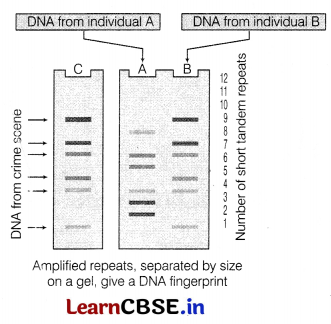
(i) Which one of the suspected individual may be involved in the crime?
(ii) What is the significance of EtBr in this process?
(iii) What is the importance of this process in biotechnology?
Answer:
(i) Individual B may be involved in the crime as his DNA fragment matches the DNA segment from the crime scene.
(ii) The DNA fragments are stained in Ethidium Bromide (EtBr) to make them visible. The stained fragments of DNA were just exposed in UV-rays, the bands of DNA become visible in bright orange colour.
(iii) DNA fingerprinting is a technique used in biotechnology laboratories to establish links between various samples of DNA.
![]()
Question 23.
Explain the outbreeding devices developed by papaya, castor and sunflower plants in order to discourage self-pollination.
Answer:
The outbreeding devices developed by various pla its are as follows
(i) In papaya, both autogamy and geitonogamy are prevented in several species, where male and female flowers are present on different plant, i.e. each plant is either male or female. This is called dioecy.
(ii) In castor, self-pollination is avoided by ciicliny. It is the presence of unisexual flowers n plants that prevents autogamy, but not geitonogamy.
(iii) In sunflower, self-pollination is avoiced by the method called dichogamy. In this, he stigma and pollen release is not synchronised, i.e the pollen is released before the stigma become receptive (protandry) or stigma become receptive before the release of pollen (protogyny).
Question 24.
Organic farmers prefer biological control of diseases and pests to the use of chemicals for the same purpose.
(i) Justify the above given statement.
(ii) Give an example of a bacterium, a fungus and an insect that are used as j biocontrol agents.
Answer:
(i) Organic farmers do not use any chemical for raising crops. They simply depend on biological control methods to control insects and pests. This way they avoid deleterious effects of chemicals on food products as well as on the environment. These chemicals get accumulated in food chain and ecosystem whereas biological control methods are safe as they do not harm any form of life.
(ii) Examples of biological control agents are as follows
(a) Bacterium Bacillus thuringiensis for the control of cotton bollworm.
(b) Fungus Trichoderma species for controlling fungal soil borne diseases like damping off of vegetables.
(c) Insects Ladybird beetle for the control of aphids.
Question 25.
Study the flowchart given below and answer the questions that follow.
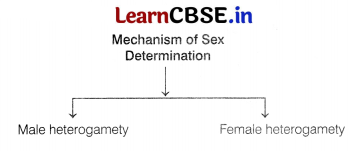
(i) Differentiate between male and female heterogamety.
(ii) Draw a schematic diagram of determination of sex in birds.
(iii) What is male digamety?
Answer:
(i) Differences between male and female heterogamety are as follows
| Male heterogamety | Female heterogame |
|
In this type, the male produces two types of gametes,
e.g. X and Y type (in human). |
In this, the female produces two types of gametes.
e.g. Z and W type (in birds). |
(ii) Sex-determination in birds (female – heterogamety)
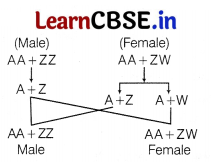
(iii) During spermatogenesis, in case of males, two types of gametes are produced out of total sperms produced 50% carry X-chromosomes and the rest 50% carry Y-chromosomes besides autosomes. This condition is called male dlgamety.
Question 26.
Explain the functions of bulbourethral i glands, fimbriae and cervix in the human reproductive system.
Answer:
The functions of following in human reproductive system are as follows
(i) Function of Bulbourethral Glands : These secrete mucus and an alkaline fluid into the urethra. The mucus helps in the lubrication of penis and neutralises urinary acid if present in urethra.
(ii) Function of Fimbriae : These are finger-like projections at the opening of Fallopian tubes that help in the collection of ovum after ovulation.
(iii) Function of Cervix : It helps in regulation of the passage of sperms into the female uterus. It also forms the birth canal along with vagina to facilitate parturition.
Question 27.
While watching news telecast, Anaya came to know that atleast 14 wooly mammoth skeletons have been found in human built traps. She got astonished and asked her mother about the significance of these fossils. Mother told that these fossils provide evidences for evolution,
(i) During evolutionary studies, scientists found that forelimb of man is similar to that of whale. Explain the reason.
(ii) Do plants provide any evidence for evolution?
(iii) How does human body depicts that it is a product of evolution?
Or
The human genome project was a landmark global scientific effort whose signature goal was to generate the first sequence of the human genome. In 2003 the Human Genome Project (HGP) produced a genome sequence that accounted for over 90% of the human genome.
(i) What do ‘Y’ and ‘B’ stand for in ‘YAC’ and ‘BAC’ used in Human Genome Project (HGP)? Mention their role in the project.
(ii) Write the percentage of the total human genome that codes for proteins and the percentage of discovered genes whose functions are known as observed during HGP.
(iii) Expand SNPs identified by scientists in HGP.
Answer:
(i) Forlimbs of man and whale are homologous organs. These originate from common ancestors and therefore, their basic structure is similar. However, these have undergone divergent evolution so as to get adapted to different habitats and perform different functions.
(ii) Yes, e.g. thorn of Bougainvillea and tendril of Cucurbita are homologous structures.
(iii) Presence of vestigial organs like wisdom tooth, vermiform appendix and atavism in some human beings shows that we are a product of evolution.
Or
(i) Y stand for yeast in the word YAC (Yeast Artificial Chromosomes) and B stands for bacteria in the word BAC (Bacterial Artificial Chromosomes). These are vectors used in cloning of DNA.
(ii) Less than 2% of the total human genome codes for protein, 50% of discovered genes are not known for their functions.
(iii) SNPs stands for Single Nucleotide Polymorphisms.
![]()
Question 28.
Various initiatives have been taken at international level for the conservation of biodiversity. Discuss in brief.
Answer:
At international level, many countries of the world have taken initiatives for the biodiversity conservation. For example, the Earth Summit was held in Rio de Janeiro in 1992, which called upon all nations to take appropriate measures for the conservation of biodiversity and its sustainable utilisation. It promoted Convention on Biological Diversity (CBD) which was signed by 152 nations. Its recommendations came into effect on 29th Dec, 1993.
The second World Summit on sustainable development was held in Johannesburg, South Africa, in 2002 in which 190 countries pledged to significantly reduce the current rate of biodiversity loss at global, regional and local levels by the year 2010. World Conservation Union, World Wide Fund (WWF) for Nature and Convention in International Trade in Endangered Species (CITES) are also working for the biodiversity conservation.
Section D
Q. Nos. 29 and 30 are case-based questions. Each question has 3 subparts with internal choice in one subpart.
Question 29.
Study the karyotype given below and answer the questions that follows.
 (i) On the basis of your observation, identify the disorder shown in the above given karyotype. Also give suitable reason to support your answer. [1]
(i) On the basis of your observation, identify the disorder shown in the above given karyotype. Also give suitable reason to support your answer. [1]
(ii) Write about the symptoms observe in the above mentioned disorder. [1]
(iii) Name and explain one of the chromosomal disorder where female are affected. [2]
Or
(iii) Name and explain one of the chromosomal disorder where additional copy of chromosome is found.
Answer:
(i) The given karyotype shows Klinefelter’s syndrome. This is because the karyotype shows an additional copy of X-chromosome, i.e. 47, XXY.
(ii) Symptoms of Klinefelter’s syndrome are
(a) individuals have masculine development, but feminine characters like development of breast.
(b) Poor beard growth and feminine pitched voice. Such individuals are sterile.
(iii) Turner’s syndrome is another chromosomal disorder but here, the females are affected. This disorder is caused due to the absence of one X-chromosome, i.e, 45 with XO. Such females are sterile as ovaries are rudimentary besides other features including lack of other secondary sexual characters.
Or
(iii) Down’s syndrome is another chromosomal disorder that is after seen in chimpanzees and other primates apart from humans. This occurs when there is a presence of an additional copy of chromosome 21 in human.
Question 30.
The data gives below shows the outbreak of malaria in India, in last 20 years due to P vivax and P. falciparum.
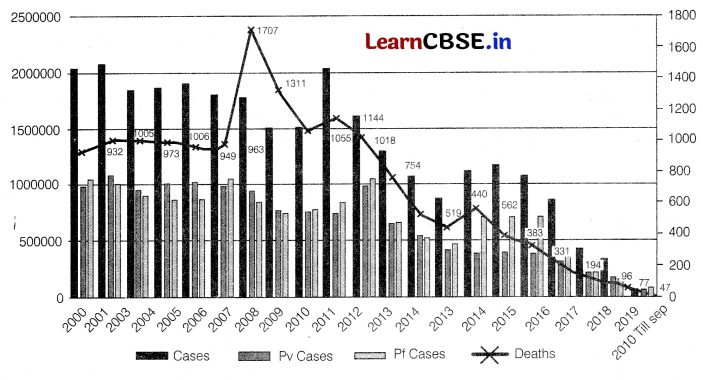
(i) With reference to the given graph find in which year, the mortality rate was very high? [1]
(ii) Name the vector of malaria. Also mention why malaria is restricted to the tropics only. [1]
(iii) According to the graph shown above, the cases of malaria are decreasing continuously. In your opinion, what can be the reason for this decline cases? [2]
Or
(iii) Trace the life cycle of malarial parasite (till asexual reproduction) in human body with the help of flowchart. [2]
Answer:
(i) In year 2008, the rate of mortality was very high due to malaria.
(ii) The vector for malaria is female Anopheles mosquito. Malaria is restricted to the tropics only because the parasite needs warm condition with temperatures above 20°C to complete its life cycle in the mosquito.
(iii) The cases of malaria have continuously decreased from 2014 because of the following reasons
(a) Better hygenic conditions, which inhibit the growth of mosquito.
(b) Effective antimalarial drugs used for the treatment of malaria such as quinine and chloroquine,
Or
(iii) Life Cycle of Malarial Parasite (Plasmodium) in Human Body
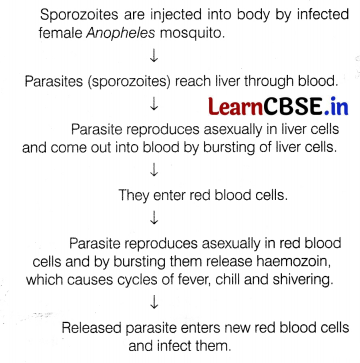
Section E
Question 31.
Given below’ are certain enzymes suggest their role in DNA replication.
| Proteins | Roles | |
| 1. | Helicase | |
| 2. | Primase | |
| 3. | Topoisomerase | |
| 4. | DNA polymerase-III | |
| 5. | DNA ligase |
Or
Given below are two situations analyse them carefully and wri te: the effect of both on the lac operon.
| Lactose | Effects | |
| 1. | Lactose is absent | |
| 2. | Lactose is present |
Answer:
The role of enzymes used in DNA replication are as follows
1. Helicase
RoleThe main function of DNA helicase is to separate both the strands of DNA.for replication. It unwinds the double helix by breaking the hydrogen bonds between the DNA strands. It also helps in the formation of replication fork.
2. Primase
Role Initiation of DNA synthesis always require a smaller segment of RNA called RNA primer. It is synthesised at 5’end of new DNA strand with the help of DNA specific RNA polymerase enzyme primase.
3. Topoisomerase
RoleThe unwinding of DNA creates a tension in the DNA strands which gets released by the enzyme topoisomerase.
4. DNA polymerase-III
Role It synthesises DNA in 5′ → 3’direction. This means the strand with 3′ → 5′ polarity wifi’ serve as a template for continuous DNA synthesis.
5. DNA ligase
Role It joins the ends of DNA segment. As is one strand the replication is continuous. While in the other strand it is discontinuous. The discontinuously synthesised fragments are joined with the enzyme DNA ligase.
Or
Lactose is known to be the inducer and the substrate for the enzyme (3-galactosidase. If lactose is provided as the carbon source in the growth medium, in the absence of the preferred carbon source such as glucose, the lactose is transported into the cells by the action of enzyme permease. The lactose then induces the operon.
When Lactose is Absent 7 ’ gene regulates and produces repressor mRNA in the absence of lactose, which blocks transcription. The repressor protein binds to the operator region of the operon and as a result prevents RNA polymerase from binding to the operon. The operon will be switched off in this situation.
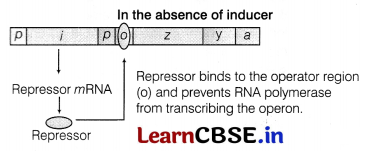
When Lactose is Present Lactose acts as an inducer here and binds to the repressor. Thus, it forms an inactive repressor. The repressor fails to bind to the operator region.
The RNA polymerase binds to the operator and transcripts lac mRNA. Lac mRNA is known to be polycistronic, which produces all three enzymes- (3-galactosidase, permease and transacetylase. In this situation, operon will be switched on.
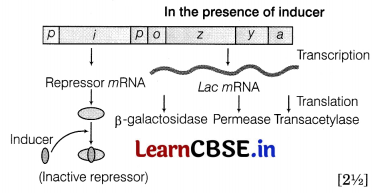
Question 32.
Toxin which originate from freshwater cyanobacterial blooms represent a widespread risk to humans, pets and other forms of life. Anabaena may produce a few different toxins, including anatoxin and microcystin. Infact, Microcystis and Anabaena are among the most toxic cyanobacterial genera that produce neurotoxins. A DNA sequencing project undertaken in 1999 revealed that the complete genome of Anabaena is 7.2 million base pairs long.
(i) Anabaena is found to play an effective role in the process of nitrogen, fixation’. How far do you agree with this statement?
(ii) Where is Anabaena usually found? Is it free-living or symbiotic?
(iii) How do cyanobacteria like Nostoc contribute towards its environment?
Or
Evolution of insect resistance has threatened the continued success of the GM crops producing Bacillus thuringiensis (Bt) toxins which are responsible for killing of insects. Analysis of more than 10 years reveals that the frequency of resistance alleles has increased substantially over the past years. The sustained efficacy of the first generation of Bt crops for a decade against almost all targeted pest populations has increased expectations of the farmers as well as the government. The graph shows reduced efficacy of insects in Bt crops.
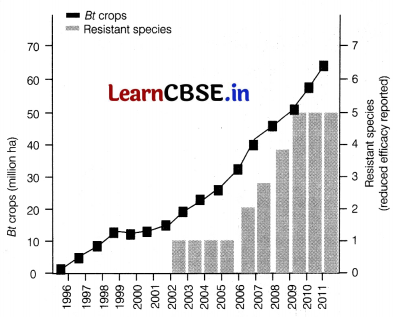
(i) Name the nematode that causes great reduction in the tobacco yield. Is any strategy involved for its prevention? Comment.
(ii) Which organisms can be controlled by the proteins encoded by the genes
(a) cry I Ab?
(b) cry II Ab?
(iii) Is Bt safe to be used in organic gardens apart from special places where genetically modified crops are grown?
Answer:
(i) Anabaena possesses specialised nitrogen-fixing cells. These specialised cells are known as heterocysts. They fix nitrogen from the air using nitrogenase enzyme.
(ii) Anabaena can be found in every environment on earth which gets sunlight.
Anabaena is a free-living nitrogen-fixing cyanobacterium that forms symbiotic association with Azolla.
(iii) They improve the soil nutrient status of organic carbon and nitrogen in arid soils.
Or
(i) Meloidogyne incognitia causes great reduction in the tobacco yield. A strategy based on the process of RNA interference (RNAi) has been adopted as a way out to prevent damage to the crops.
This method involves silencing of a specific mRNA due to complementary dsRNA molecule that binds to and prevents translation of mRNA.
(ii) (a) cry I Ab controls corn borer.
(b) cry II Ab controls cotton bollworms.
(iii) Bt is safe for use in organic gardens as it always works on specific targets and is non-toxic to humans, animals and insects which are useful for agriculture purposes.
However, for our own safety, we must wash all the vegetables and fruits thoroughly before consuming.
![]()
Question 33.
Explain the process of fertilisation and implantation in human.
Or
Angiospermic flowers may be monoecious, cleistogamous or show self-incompatibility. Describe the characteristic features of each one of them and state which one of these flowers promotes inbreeding and outbreeding, respectively.
Answer:
Fertilisation is the process of fusion of a sperm with an ovum.
(i) The motile sperms move through the cervix, enter the uterus and reach the junction of the isthmus and ampulla (ampullary-isthmic junction) of the Fallopian tube.
(ii) The ovum released from the ovary also reaches the ampullary-isthmic junction where fertilisation takes place.
(iii) Fertilisation can only occur if the ovum and sperms are transported simultaneously to this junction. This explains why all copulations do not lead to fertilisation and pregnancy.
(iv) The sperm comes in contact with the zona pellucida of the ovum and releases sperm lysins
which induces changes in the egg membrane. It blocks the entry of the other sperms into the egg. Thus, it ensures that only one sperm can fertilise an ovum.
(v) The secretions of the acrosome help the sperm to enter into the cytoplasm of the ovum through the zona pellucida and the plasma membrane.
(vi) This induces the completion of meiotic division of the secondary oocyte. The secondary meiotic division results in the formation of a secondary polar body and a haploid ovum (ootid).
(vi) The haploid nucleus of the sperm and that of ovum fuse together to form a diploid zygote.
Implantation The mitotic division starts as the zygote moves through the isthmus of the oviduct towards the uterus called cleavage, thus forming 2, 4, 8, 16 daughter cells called biastomeres.
(i) The embryo with 8-16 biastomeres is called morula. But, it is not larger than a zygote.
(ii) The morula continues to divide and transforms into blastocyst as it moves further into the uterus.
(iii) The biastomeres in the blastocyst get arranged into an outer layer called trophoblast and the inner group of cells attached to trophoblast called the inner cell mass.
(iv) The trophoblast layer then gets attached to the endometrium and the inner cell mass differentiates into the embryo. After attachment, the uterine cells divide rapidly and cover the blastocyst.
As a result, the blastocyst becomes embedded in the endometrium of the uterus. This is called implantation and it leads to pregnancy.
Or
The characteristic features of angiospermic flowers are as follows
(i) Monoecious flowers are unisexual, i.e. they have either the male reproductive or female reproductive part in separate flowers, both produced on same plant. The flowers (male and female) are separate. It prevents self- pollination and promotes cross-pollination,
(ii) Cleistogamous flowers are those flowers in which anthers and stigmas lie close to each other and do not open at all, even at maturity. These flowers are invariably autogamous and promote inbreeding depression as there is no chance for cross-pollination at all.
(iii) Self-incompatible In angiospermic flowers, there is a genetic mechanism, wherein the flowers prevent the self-pollens from fertilising the ovules or inhibit their germination on stigma. This device or mechanism promotes outbreeding.